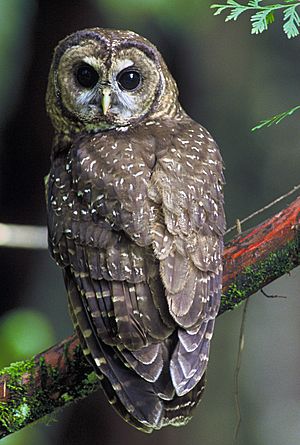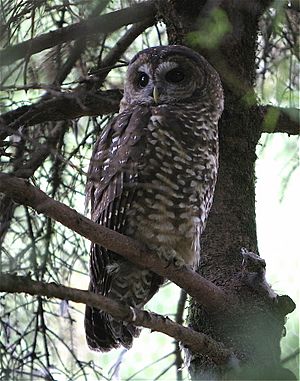Northern spotted owl facts for kids
Quick facts for kids Strix occidentalis caurina |
|
|---|---|
 |
|
| Conservation status | |
| Scientific classification |
|
| Kingdom: | Animalia |
| Phylum: | Chordata |
| Class: | Aves |
| Order: | Strigiformes |
| Family: | Strigidae |
| Genus: | Strix |
| Species: | |
| Subspecies: |
S. o. caurina
|
| Trinomial name | |
| Strix occidentalis caurina (Merriam, 1898)
|
|
The northern spotted owl (Strix occidentalis caurina) is a special type of spotted owl. It's one of three different kinds, or subspecies, of spotted owls. This medium-sized, dark brown owl lives in the Pacific Northwest region of North America.
Northern spotted owls are part of the true owl family, called Strigidae. They are considered an important indicator species. This means their health tells us about the health of their environment. Sadly, the northern spotted owl is a threatened species. Its numbers are shrinking because of habitat loss and competition from other owls.
Contents
About the Northern Spotted Owl
Northern spotted owls have dark brown feathers with white spots. Unlike some owls, they don't have ear tufts. They are usually about 16 to 19 inches long. They weigh around one to one and a sixth pounds. Female owls are a bit bigger than males. Their wings can spread about 42 inches wide.
These owls are mostly active at night, which means they are nocturnal. They also form strong, long-lasting pairs. Most owls have yellow or orange eyes. But northern spotted owls are special because they have dark-colored eyes.
What Sounds Do They Make?
Northern spotted owls make 13 different sounds. These include hoots, whistles, and barks. Female owls usually have higher-pitched calls than males.
Hoots are often used to announce things. This could be about their territory or finding prey. Females often use whistles to get the attention of males. Barks are used when owls have arguments over their territory.
Where They Live
Northern spotted owls mostly live in old growth forests. These are very old forests with large, mature trees. You can find them from southern British Columbia in Canada down to northern California. They live along the Pacific Ocean coast.
Most northern spotted owls live on government-protected lands. These include Forest Service and National Park Service areas. Some also live on state lands in Washington, Oregon, and California. They can also be found on lands owned by Native American tribes and private owners.
Native American tribes manage about 500,000 acres of forest where these owls live. Each tribe creates its own plans to protect the owls. However, everyone must follow the Endangered Species Act. This is a United States federal law that protects endangered animals.
Northern spotted owls build their nests in tree hollows or on large branches. They might also use old nests built by other birds. These owls usually stay in the same area. They only move if conditions get too harsh or if they can't find enough food.
What They Eat
The northern spotted owl's diet is mostly small mammals. About 91.5% of their food comes from these animals. They also eat other birds (4.3%) and insects (4.1%). A tiny bit (0.1%) comes from other prey.
Most of their prey are active at night, just like the owls. Their main foods include northern flying squirrels and woodrats. They also eat red tree voles, western red-backed voles, and gophers. The exact diet can change depending on where the owls live. It also depends on how many small nocturnal animals are in the area.
Recently, barred owls have moved into the northern spotted owl's territory. Barred owls eat similar foods. This means there is less food available for the northern spotted owls.
How They Behave
Northern spotted owls don't like it when their habitat is disturbed. Each pair of owls needs a large area for hunting and nesting. They usually don't move unless there are big changes in seasons. For example, heavy snow can make hunting very hard.
Their flight is special. They flap their wings quickly, then glide silently. This helps them sneak up on their prey without being heard.
Reproduction and Life Cycle
Northern spotted owls can start having babies at two years old. But they usually don't breed until they are three. Males and females mate in February or March. The female then lays two or three eggs in March or April.
The female owl sits on the eggs for about 30 days until they hatch. After the young owls hatch, they stay in the nest. The mother owl takes care of them. The young owls can fly after about 34 to 36 days. During this time, the male owl does all the hunting and feeding.
The young owls stay with their parents until late summer or early fall. Then they leave the nest to find their own hunting grounds for the winter. By spring, the young owls will have their own territory. This new territory can be from 2 to 24 miles away from their parents.
Protecting the Northern Spotted Owl
There are very few northern spotted owls left in British Columbia, Canada. In Oregon, there are about 1,200 pairs. Northern California has about 560 pairs, and Washington has 500 pairs. Washington has lost over 90% of its old growth forest due to logging. This has caused a huge drop in the owl population.
The worldwide IUCN Red List calls the spotted owl species "Near Threatened". Its population is decreasing. This status covers all spotted owls in Canada, the United States, and Mexico.
In Canada, the northern spotted owl was declared endangered in 2002. As of 2010, only 6 pairs were known in the wild in British Columbia. This is a big drop from the 500 pairs that used to live there.
The United States Fish and Wildlife Service listed the northern spotted owl as a threatened species on June 23, 1990. This was because of the loss of their old-growth forest homes. Logging in national forests where these owls lived was stopped by a court order in 1991.
In 2007, a special program was started in Canada. It's called the Captive Breeding and Release Program. Its goal is to raise owls in captivity. Then, they release them into protected areas. This helps prevent the species from disappearing from Canada. The program hopes to grow the captive population to 10 breeding pairs. They also want to release 10-20 young owls each year. These owls will go into 300,000 hectares of protected old-growth forest. The long-term goal is to bring the wild population back to about 300 adult owls.
Barred Owl Invasion
Why Northern Spotted Owl Numbers Are Dropping
The barred owl is an owl species that used to live only in the Eastern United States. But now, they have spread west. They have moved into the same areas where northern spotted owls live. Barred owls eat small mammals, other birds, and even amphibians and fish. This diet is very similar to what northern spotted owls eat.
When barred owls move in, there's more competition for food. Northern spotted owls need a much larger area to find enough food than barred owls do. As more barred owls move in, it becomes even harder for northern spotted owls to find food.
Barred owls also eat a wider variety of food. This gives them an advantage over the northern spotted owl. It also affects the balance of nature in these habitats. The biggest impact is on the northern spotted owl population. Their numbers have dropped by about 3.8% each year from 1985 to 2013. This drop is directly linked to the presence of barred owls.
Studies have shown that if barred owls are removed, northern spotted owl populations can increase. But if barred owls are left alone, the northern spotted owl numbers keep going down. Protecting the owls' habitat is important. But controlling the barred owl population could help save the northern spotted owl from extinction.
Hybrid Owls
Northern spotted owls and barred owls can sometimes have babies together. These babies are called hybrids. Before, they lived in different places, so this didn't happen. Now, it's hard to tell a hybrid from a pure northern spotted owl without genetic tests.
However, hybrids tend to be larger and lighter in color. They also have faces similar to barred owls. All the hybrids found so far have come from male northern spotted owls and female barred owls. This cross-breeding is rare. It's not a major threat to either species. The biggest problem is the direct competition for food and living space.
There's also been some genetic evidence of northern spotted owls breeding with California spotted owls. But since both are types of spotted owls, this is not considered true hybridization.
Images for kids




